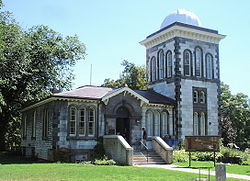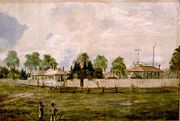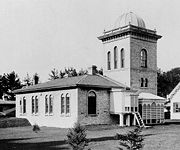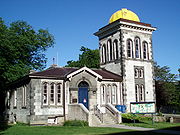
Toronto Magnetic and Meteorological Observatory
Encyclopedia

Observatory
An observatory is a location used for observing terrestrial or celestial events. Astronomy, climatology/meteorology, geology, oceanography and volcanology are examples of disciplines for which observatories have been constructed...
located on the grounds of the University of Toronto
University of Toronto
The University of Toronto is a public research university in Toronto, Ontario, Canada, situated on the grounds that surround Queen's Park. It was founded by royal charter in 1827 as King's College, the first institution of higher learning in Upper Canada...
, in Toronto
Toronto
Toronto is the provincial capital of Ontario and the largest city in Canada. It is located in Southern Ontario on the northwestern shore of Lake Ontario. A relatively modern city, Toronto's history dates back to the late-18th century, when its land was first purchased by the British monarchy from...
, Ontario
Ontario
Ontario is a province of Canada, located in east-central Canada. It is Canada's most populous province and second largest in total area. It is home to the nation's most populous city, Toronto, and the nation's capital, Ottawa....
, Canada
Canada
Canada is a North American country consisting of ten provinces and three territories. Located in the northern part of the continent, it extends from the Atlantic Ocean in the east to the Pacific Ocean in the west, and northward into the Arctic Ocean...
. The original building was constructed in 1840 as part of a worldwide research project run by Edward Sabine
Edward Sabine
General Sir Edward Sabine KCB FRS was an Irish astronomer, geophysicist, ornithologist and explorer.Two branches of Sabine's work in particular deserve very high credit: Determination of the length of the seconds pendulum, a simple pendulum whose time period on the surface of the Earth is two...
to determine the cause of fluctuations in magnetic declination
Magnetic declination
Magnetic declination is the angle between magnetic north and true north. The declination is positive when the magnetic north is east of true north. The term magnetic variation is a synonym, and is more often used in navigation...
. Measurements from the Toronto site demonstrated that sunspot
Sunspot
Sunspots are temporary phenomena on the photosphere of the Sun that appear visibly as dark spots compared to surrounding regions. They are caused by intense magnetic activity, which inhibits convection by an effect comparable to the eddy current brake, forming areas of reduced surface temperature....
s were responsible for this effect on Earth's magnetic field
Earth's magnetic field
Earth's magnetic field is the magnetic field that extends from the Earth's inner core to where it meets the solar wind, a stream of energetic particles emanating from the Sun...
. When this project concluded in 1853, the observatory was greatly expanded by the Canadian government and served as the country's primary meteorological station and official timekeeper for over fifty years. The observatory is considered the birthplace of Canadian astronomy.
Sabine's study

Compass
A compass is a navigational instrument that shows directions in a frame of reference that is stationary relative to the surface of the earth. The frame of reference defines the four cardinal directions – north, south, east, and west. Intermediate directions are also defined...
es tended to "wander" from north when measurements were taken at different locations or even at a single location over a period of time. The astronomer Edmund Halley first noted this and the problems it would cause for navigation
Navigation
Navigation is the process of monitoring and controlling the movement of a craft or vehicle from one place to another. It is also the term of art used for the specialized knowledge used by navigators to perform navigation tasks...
in 1701. It was also believed that whatever was causing this effect might be causing changes in the weather, and that studying magnetic variance might lead to better weather prediction.
In 1833 the British Association for the Advancement of Science
British Association for the Advancement of Science
frame|right|"The BA" logoThe British Association for the Advancement of Science or the British Science Association, formerly known as the BA, is a learned society with the object of promoting science, directing general attention to scientific matters, and facilitating interaction between...
commissioned a series of magnetic measurements across the United Kingdom
United Kingdom
The United Kingdom of Great Britain and Northern IrelandIn the United Kingdom and Dependencies, other languages have been officially recognised as legitimate autochthonous languages under the European Charter for Regional or Minority Languages...
. Under the direction of Major Edward Sabine
Edward Sabine
General Sir Edward Sabine KCB FRS was an Irish astronomer, geophysicist, ornithologist and explorer.Two branches of Sabine's work in particular deserve very high credit: Determination of the length of the seconds pendulum, a simple pendulum whose time period on the surface of the Earth is two...
of the Royal Artillery
Royal Artillery
The Royal Regiment of Artillery, commonly referred to as the Royal Artillery , is the artillery arm of the British Army. Despite its name, it comprises a number of regiments.-History:...
, a multi-year measuring project began, with the results to be published in 1838. As the measurements were being made a number of proposals were put forth to expand the program worldwide. In 1836 the German explorer and naturalist Alexander von Humboldt
Alexander von Humboldt
Friedrich Wilhelm Heinrich Alexander Freiherr von Humboldt was a German naturalist and explorer, and the younger brother of the Prussian minister, philosopher and linguist Wilhelm von Humboldt...
wrote to Prince Augustus Frederick, Duke of Sussex
Prince Augustus Frederick, Duke of Sussex
The Prince Augustus Frederick, Duke of Sussex , was the sixth son of George III of the United Kingdom and his consort, Charlotte of Mecklenburg-Strelitz. He was the only surviving son of George III who did not pursue an army or naval career.- Early life :His Royal Highness The Prince Augustus...
, then President of the Royal Society
Royal Society
The Royal Society of London for Improving Natural Knowledge, known simply as the Royal Society, is a learned society for science, and is possibly the oldest such society in existence. Founded in November 1660, it was granted a Royal Charter by King Charles II as the "Royal Society of London"...
, stating that a formal program was important to a nation with dominions spread across the globe. At the seventh meeting of the Royal Society in Liverpool in 1837, Sabine declared that "the magnetism of the earth cannot be counted less than one of the most important branches of the physical history of the planet we inhabit" and mapping its variations would be "regarded by our contemporaries and by posterity as a fitting enterprise of a maritime people; and a worthy achievement of a nation which has ever sought to rank foremost in every arduous undertaking".
In 1837, the University of Dublin
University of Dublin
The University of Dublin , corporately designated the Chancellor, Doctors and Masters of the University of Dublin , located in Dublin, Ireland, was effectively founded when in 1592 Queen Elizabeth I issued a charter for Trinity College, Dublin, as "the mother of a university" – this date making it...
funded the installation of a magnetic observatory at Greenwich
Greenwich
Greenwich is a district of south London, England, located in the London Borough of Greenwich.Greenwich is best known for its maritime history and for giving its name to the Greenwich Meridian and Greenwich Mean Time...
. The Association continued to press for the construction of similar observatories around the world, and in 1838 their suggestions were accepted by the Government and funds were provided. In 1839 the British Government and the Royal Society prepared four expeditions to build magnetic observation stations in Cape Town
Cape Town
Cape Town is the second-most populous city in South Africa, and the provincial capital and primate city of the Western Cape. As the seat of the National Parliament, it is also the legislative capital of the country. It forms part of the City of Cape Town metropolitan municipality...
, St. Helena, Hobart, Tasmania, and (eventually) Toronto
Toronto
Toronto is the provincial capital of Ontario and the largest city in Canada. It is located in Southern Ontario on the northwestern shore of Lake Ontario. A relatively modern city, Toronto's history dates back to the late-18th century, when its land was first purchased by the British monarchy from...
. Teams of Royal Artillery officers were sent out to take the measurements. The team assigned to Canada originally planned to build their observatory on Saint Helen's Island
Saint Helen's Island
Saint Helen's Island is an island in the Saint Lawrence River, in the territory of the city of Montreal. It is situated immediately southeast of the Island of Montreal, in the extreme southwest of Quebec. It forms part of the Hochelaga Archipelago...
off Montreal
Montreal
Montreal is a city in Canada. It is the largest city in the province of Quebec, the second-largest city in Canada and the seventh largest in North America...
, but the local rocks proved to have a high magnetic influence, and the decision was made to move to Toronto instead. The team arrived in 1839, and set up camp at Fort York
Fort York
Fort York is a historic site of military fortifications and related buildings on the west side of downtown Toronto, Ontario, Canada. The fort was built by the British Army and Canadian militia troops in the late 18th and early 19th centuries, to defend the settlement and the new capital of the...
in a disused barracks while construction started on new buildings. The observatory was given 10 acres (4 ha) of land to the west of King's College; the Ontario Legislature now occupies the area on which the college was located.
The observatory, officially "Her Majesty's Magnetical and Meteorological Observatory at Toronto", was completed the following year. It consisted of two log buildings, one for the magnetic instruments and the other a smaller semi-buried building nearby for "experimental determinations". The north end of the main building was connected to a small conical dome which contained a theodolite
Theodolite
A theodolite is a precision instrument for measuring angles in the horizontal and vertical planes. Theodolites are mainly used for surveying applications, and have been adapted for specialized purposes in fields like metrology and rocket launch technology...
used to make astronomical measurements for the accurate determination of the local time. The buildings were constructed with as little metal as possible; when metal was required, non-magnetic materials such as brass
Brass
Brass is an alloy of copper and zinc; the proportions of zinc and copper can be varied to create a range of brasses with varying properties.In comparison, bronze is principally an alloy of copper and tin...
or copper
Copper
Copper is a chemical element with the symbol Cu and atomic number 29. It is a ductile metal with very high thermal and electrical conductivity. Pure copper is soft and malleable; an exposed surface has a reddish-orange tarnish...
were used. A small barracks was built nearby to house the crew.
Using the measurements from the Toronto and Hobart sites, Sabine noticed both short-term fluctuations in magnetic declination over a period of hours, and longer-term variations over months. He quickly concluded that the short term variations were due to the day/night cycle, while the longer term ones were due to the number of visible sunspots. He published two introductory papers on the topic in the Philosophical Transactions of the Royal Society
Philosophical Transactions of the Royal Society
The Philosophical Transactions of the Royal Society is a scientific journal published by the Royal Society of London. It was established in 1665, making it the first journal in the world exclusively devoted to science, and it has remained in continuous publication ever since, making it the world's...
. The first, in 1851, was a collection of early measurements; the second in 1852 correlated with Heinrich Schwabe
Heinrich Schwabe
Samuel Heinrich Schwabe a German astronomer remembered for his work on sunspots.Schwabe was born at Dessau. At first an apothecary, he turned his attention to astronomy, and in 1826 commenced his observations on sunspots. Schwabe was trying to discover a new planet inside the orbit of Mercury...
's sunspot measurements, which had been made widely available in Alexander von Humboldt's Cosmos, also published in 1851. With further data collected from the Toronto site, Sabine was able to demonstrate conclusively that the eleven-year sunspot cycle caused a similarly periodic variation in the Earth's magnetic field. He presented a third and conclusive paper on the topic in 1856, "On Periodical Laws Discoverable in the Mean Effects of the Larger Magnetic Disturbances", in which he singled out the Toronto site for particular praise.
Meteorological service


Meteorological Service of Canada
The Meteorological Service of Canada , also known as "The Canadian Weather Service", is a division of Environment Canada, which primarily provides public meteorological information and weather forecasts and warnings of severe weather and other environmental hazards...
) under the direction of the Ministry of Marine and Fisheries
Fisheries and Oceans Canada
Fisheries and Oceans Canada, frequently referred to as DFO , is the department within the government of Canada that is responsible for developing and implementing policies and programs in support of Canada's economic, ecological and scientific interests in oceans and inland waters...
. During the expansion, the original buildings were replaced with a permanent structure.
The current building was designed in 1853 by local architect Frederick Cumberland
Frederick William Cumberland
Frederick William Cumberland was a Canadian engineer, architect and political figure. He represented the riding of Algoma in the 1st and 2nd Ontario Parliaments and in the Canadian House of Commons from 1871 to 1872....
, who was also working on the design of University College
University College, University of Toronto
University College is a constituent college of the University of Toronto, created in 1853 specifically as an institution of higher learning free of religious affiliation. It was the founding member of the university's modern collegiate system, and its secularism contrasted with contemporary...
, which was being built just north of the Observatory to replace King's College. The new observatory design called for a stone building, with an attached tower containing the theodolite. The new building was completed in 1855, and stood directly opposite the entrance of today's Convocation Hall.
During its time as a meteorological station, the observatory collected reports from 312 observation stations in Canada and another 36 in the United States. Each station was equipped with a "Mercurial Barometer, two Thermometers (a maximum and a minimum Thermometer), an Anemometer to measure the velocity of the wind, a Wind Vane and a Rain Gauge". Reports were sent in coded form to the Observatory at 8 am and 8 pm every day, Eastern Standard Time
Eastern Standard Time
Eastern Standard Time may refer to:*North American Eastern Time Zone, UTC-5*Australian Eastern Standard Time, UTC+10*An album by Hip Hop group Kooley High...
(then known as "75th meridian time"), and used to produce a chart predicting the weather for the following 36 hours. These predictions were then telegraphed across the country, and charts were distributed to newspapers and the Board of Trade, where they could be viewed by the public. With the installation of telephones, the Observatory also offered weather reports on demand, which was an important service to fruit vendors, who used the reports to plan shipping.
Among its other uses, in 1880, measurements from the site were used as part of the effort to develop standard time
Standard time
Standard time is the result of synchronizing clocks in different geographical locations within a time zone to the same time rather than using the local meridian as in local mean time or solar time. Historically, this helped in the process of weather forecasting and train travel. The concept...
. The observatory remained the official timekeeper for Canada until 1905, when that responsibility was transferred to Ottawa
Ottawa
Ottawa is the capital of Canada, the second largest city in the Province of Ontario, and the fourth largest city in the country. The city is located on the south bank of the Ottawa River in the eastern portion of Southern Ontario...
's Dominion Observatory
Dominion Observatory
The Dominion Observatory was an astronomical observatory in Ottawa, Canada that operated from 1902 to 1970. The Observatory was also an institution within the Canadian Federal Government. The observatory grew out of the Department of the Interior's need for the precise coordinates and timekeeping...
. At exactly 11:55 am the clocks in Toronto fire halls were rung by an electrical signal from the Observatory.
In 1881 the observatory's director, Charles Carpmeal, suggested adding a high-quality telescope to the observatory. He felt that direct solar observations would lead to a better understanding of sunspot effects on weather (as late as 1910 the observatory's then-director, R. F. Stupart, noted that "sun spots have more to do with our weather conditions than have the rings around the moon."). Coincidentally, the Canadian government (having formed in 1867
Canadian Confederation
Canadian Confederation was the process by which the federal Dominion of Canada was formed on July 1, 1867. On that day, three British colonies were formed into four Canadian provinces...
) was interested in taking part in the major international effort to accurately record the December 1882 Transit of Venus
Transit of Venus
A transit of Venus across the Sun takes place when the planet Venus passes directly between the Sun and Earth, becoming visible against the solar disk. During a transit, Venus can be seen from Earth as a small black disk moving across the face of the Sun...
.
Funds were provided for the purchase of a 6-inch (150 mm) refracting telescope
Refracting telescope
A refracting or refractor telescope is a type of optical telescope that uses a lens as its objective to form an image . The refracting telescope design was originally used in spy glasses and astronomical telescopes but is also used for long focus camera lenses...
from T. Cooke & Sons
T. Cooke & Sons
T. Cooke & Sons was a British instrument-making firm, founded by Thomas Cooke.The firm built the clock face on the Darlington clock tower.In 1922 it merged with Troughton & Simms to form Cooke, Troughton & Simms.-References:* *...
. The dome was originally designed to mount a small transit, and the lengthy telescope, over 2 metres long, had a limited field of view though the dome's opening. A large stone pillar was constructed inside the tower, raising the telescope to bring it closer to the dome and improve its field of view. Unfortunately, the new telescope was unable to take part in the transit measurements due to bad weather, and missed the 1895 Transit of Mercury
Transit of Mercury
A transit of Mercury across the Sun takes place when the planet Mercury comes between the Sun and the Earth, and Mercury is seen as a small black dot moving across the face of the Sun....
for the same reason.
Relocation

College Street (Toronto)
College Street is a principal arterial thoroughfare in downtown Toronto, connecting former streetcar suburbs in the west with the city centre. The street is home to an ethnically diverse population in the western residential reaches, and institutions like the Ontario Legislature and the University...
just to the south, and the large quantities of metal used in the modern buildings surrounding the site threw off the instruments. A new magnetic observatory opened in 1898 in Agincourt
Agincourt, Toronto
Agincourt is a very diverse neighbourhood in the Scarborough district of the city of Toronto, Ontario, Canada. It is centred along Sheppard Avenue between Kennedy and Markham Roads...
—now a suburban area in the northeast of the city—leaving the campus location with its meteorological and solar observation duties.
By 1907, new university buildings completely surrounded the observatory; dust from the construction clogged meteorological instruments, and at night electric lighting made astronomical work impossible. The Meteorological Office decided to abandon the site and move to a new building at the north end of campus on Bloor Street
Bloor Street
Bloor Street is a major east–west residential and commercial thoroughfare in Toronto, in the Canadian province of Ontario. Bloor Street runs from the Prince Edward Viaduct westward into Mississauga, where it ends at Central Parkway. East of the viaduct, Danforth Avenue continues along the same...
, trading the original Observatory to the University in exchange for the new parcel of land. There was some discussion regarding what to do with the Cooke telescope, since the Meteorological Office had little use for this purely astronomical instrument. No other use was immediately forthcoming, and the telescope moved along with the Meteorological Office to their new Bloor Street Observatory.
The university assumed ownership of the now-disused observatory building and was originally going to abandon it. Louis Beaufort Stewart
Louis Beaufort Stewart
Louis Beaufort Stewart was a Canadian astronomer, civil engineer and academic. He served as the president of the Royal Astronomical Society of Canada from 1912 to 1913, and played a key role in preserving the Toronto Magnetic and Meteorological Observatory building at the University of...
, a lecturer in the Faculty of Applied Science and Engineering, campaigned for it to be saved for the Department of Surveying and Geodesy. He eventually arranged for the building to be re-constructed on a more suitable site. Demolition work was carried out in 1907: the stones were simply left in place over the winter, and were used the following year to construct a re-arranged building just east of the main University College building (south of Hart House).
In 1930 the Meteorological Office no longer used the Cooke telescope, and agreed to donate it to the university if they would handle its removal. Both the telescope and the observatory dome were moved to the observatory building. The telescope moved once again in 1952 to the David Dunlap Observatory
David Dunlap Observatory
The David Dunlap Observatory is a large astronomical observatory site once owned by the University of Toronto, located just north of the city in Richmond Hill, Ontario within a estate. Its primary instrument is a 74-inch reflector telescope, at one time the second largest telescope in the world,...
north of the city, and in 1984 it was donated to the Canada Science and Technology Museum
Canada Science and Technology Museum
The Canada Science and Technology Museum is located in Ottawa, Ontario, on St. Laurent Boulevard, to the south of the Queensway .-Mission:...
. The Department of Surveying and Geodesy used the observatory until the 1950s. Since then the office areas have been used for a variety of purposes, including a police substation and a telephone switchboard. The building was handed over to the Students' Administrative Council (now University of Toronto Students' Union) in 1953, which has used the building since then. The dome, now unused, receives a yearly multi-colour paint job by engineering students. The name of Louis Beaufort Stewart Observatory was adopted in the 1980s.

